An Analysis of Capital Budgeting Techniques in Corporate Finance
VerifiedAdded on 2020/03/28
|12
|3617
|39
Report
AI Summary
This report provides an overview of capital budgeting techniques used in corporate financial management. It begins by defining capital budgeting as a process for evaluating long-term investments and highlights its importance for both company development and overall economic growth. The report then classifies capital budgeting techniques into conventional and discounted cash flow methods, with a focus on the latter. Key techniques such as Payback Period, Net Present Value (NPV), Internal Rate of Return (IRR), Probability Index (PI), Sensitivity Analysis, and Scenario Analysis are explained in detail. The report outlines the formulas, applications, advantages, and limitations of each technique, emphasizing their roles in investment decision-making. It also explores the application of sensitivity analysis and scenario analysis in assessing project risks and uncertainties, with a discussion on their steps and implications. The report concludes by underscoring the significance of these techniques in helping managers maximize shareholder wealth and make informed investment decisions.
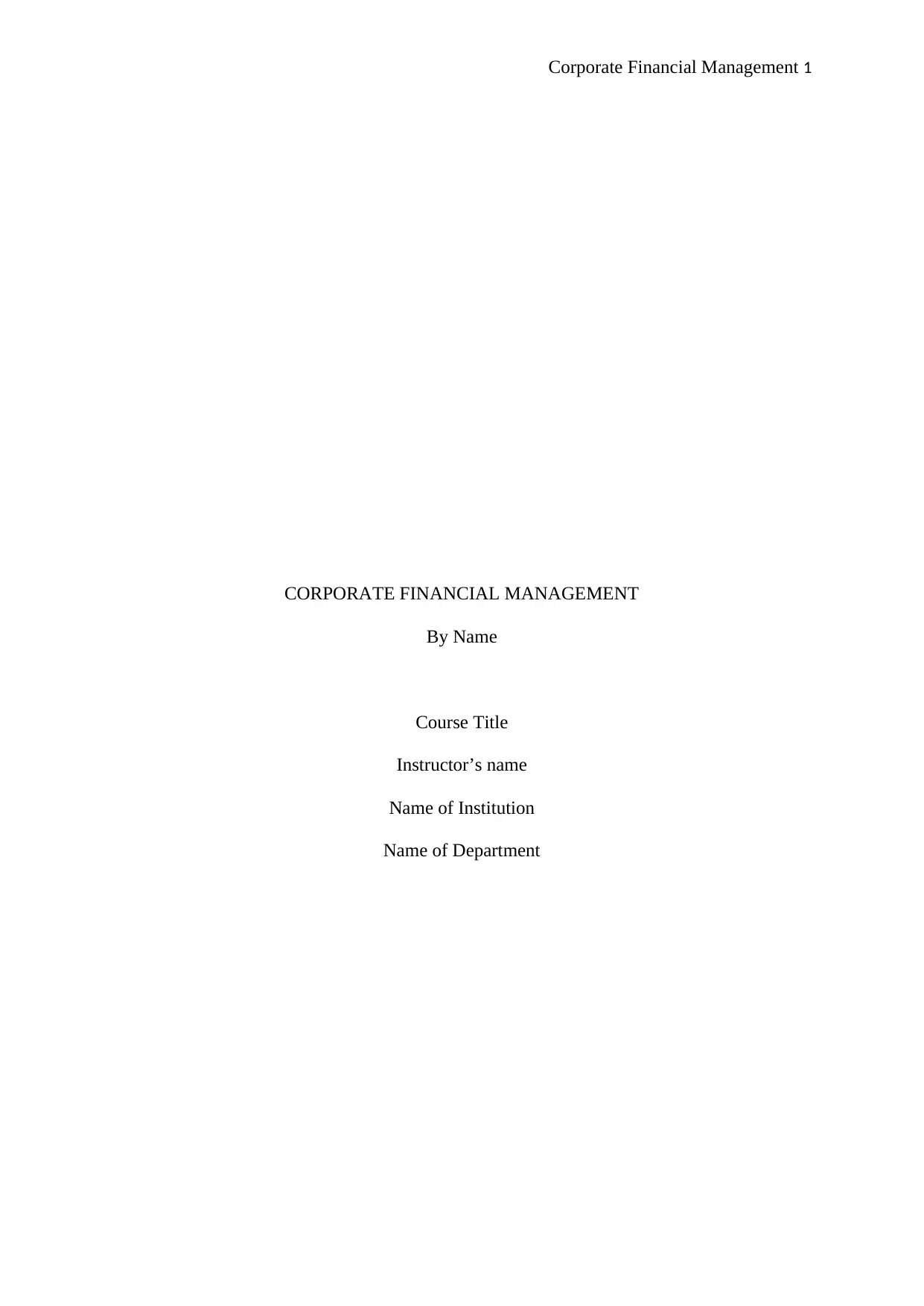
Corporate Financial Management 1
CORPORATE FINANCIAL MANAGEMENT
By Name
Course Title
Instructor’s name
Name of Institution
Name of Department
CORPORATE FINANCIAL MANAGEMENT
By Name
Course Title
Instructor’s name
Name of Institution
Name of Department
Paraphrase This Document
Need a fresh take? Get an instant paraphrase of this document with our AI Paraphraser
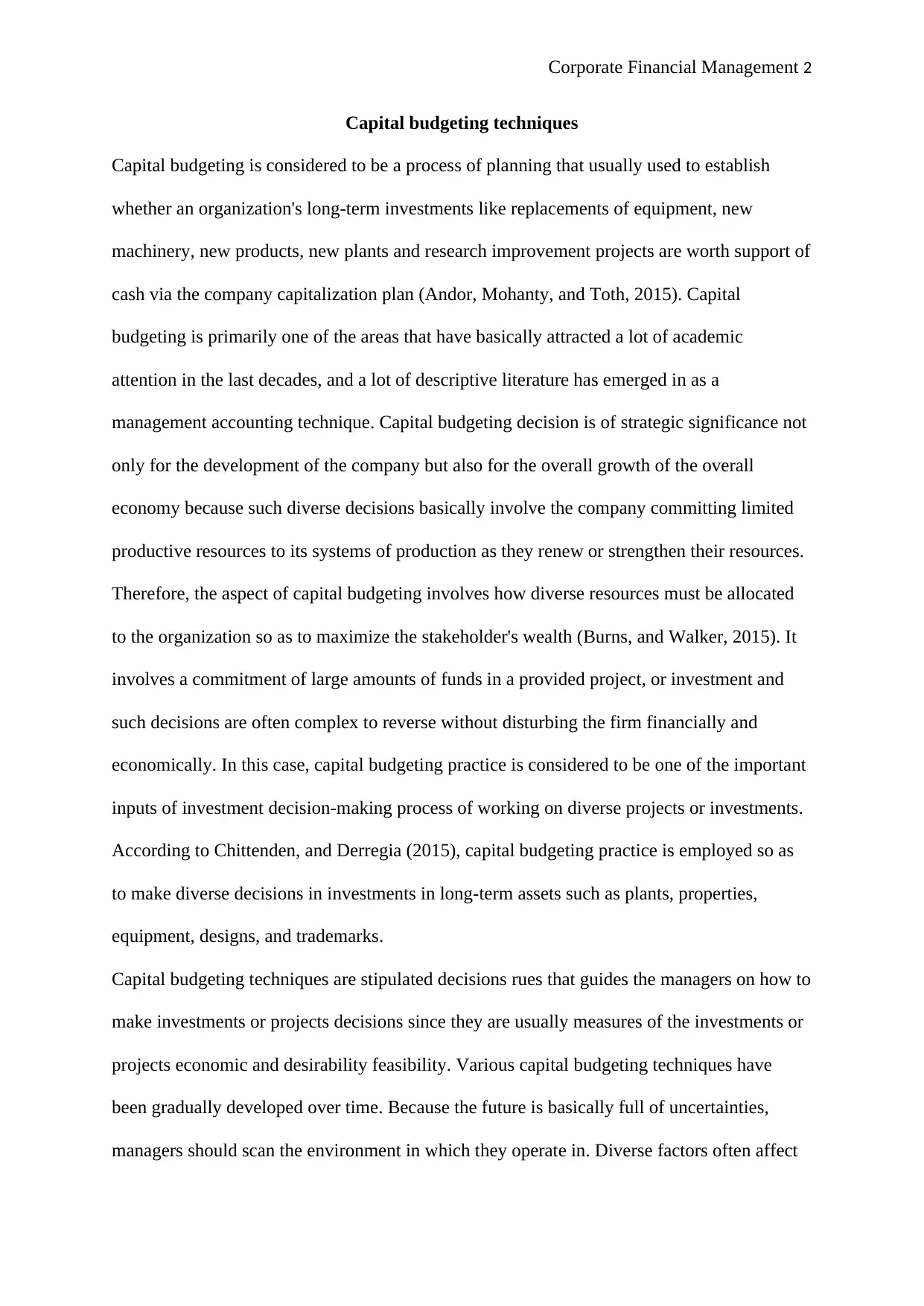
Corporate Financial Management 2
Capital budgeting techniques
Capital budgeting is considered to be a process of planning that usually used to establish
whether an organization's long-term investments like replacements of equipment, new
machinery, new products, new plants and research improvement projects are worth support of
cash via the company capitalization plan (Andor, Mohanty, and Toth, 2015). Capital
budgeting is primarily one of the areas that have basically attracted a lot of academic
attention in the last decades, and a lot of descriptive literature has emerged in as a
management accounting technique. Capital budgeting decision is of strategic significance not
only for the development of the company but also for the overall growth of the overall
economy because such diverse decisions basically involve the company committing limited
productive resources to its systems of production as they renew or strengthen their resources.
Therefore, the aspect of capital budgeting involves how diverse resources must be allocated
to the organization so as to maximize the stakeholder's wealth (Burns, and Walker, 2015). It
involves a commitment of large amounts of funds in a provided project, or investment and
such decisions are often complex to reverse without disturbing the firm financially and
economically. In this case, capital budgeting practice is considered to be one of the important
inputs of investment decision-making process of working on diverse projects or investments.
According to Chittenden, and Derregia (2015), capital budgeting practice is employed so as
to make diverse decisions in investments in long-term assets such as plants, properties,
equipment, designs, and trademarks.
Capital budgeting techniques are stipulated decisions rues that guides the managers on how to
make investments or projects decisions since they are usually measures of the investments or
projects economic and desirability feasibility. Various capital budgeting techniques have
been gradually developed over time. Because the future is basically full of uncertainties,
managers should scan the environment in which they operate in. Diverse factors often affect
Capital budgeting techniques
Capital budgeting is considered to be a process of planning that usually used to establish
whether an organization's long-term investments like replacements of equipment, new
machinery, new products, new plants and research improvement projects are worth support of
cash via the company capitalization plan (Andor, Mohanty, and Toth, 2015). Capital
budgeting is primarily one of the areas that have basically attracted a lot of academic
attention in the last decades, and a lot of descriptive literature has emerged in as a
management accounting technique. Capital budgeting decision is of strategic significance not
only for the development of the company but also for the overall growth of the overall
economy because such diverse decisions basically involve the company committing limited
productive resources to its systems of production as they renew or strengthen their resources.
Therefore, the aspect of capital budgeting involves how diverse resources must be allocated
to the organization so as to maximize the stakeholder's wealth (Burns, and Walker, 2015). It
involves a commitment of large amounts of funds in a provided project, or investment and
such decisions are often complex to reverse without disturbing the firm financially and
economically. In this case, capital budgeting practice is considered to be one of the important
inputs of investment decision-making process of working on diverse projects or investments.
According to Chittenden, and Derregia (2015), capital budgeting practice is employed so as
to make diverse decisions in investments in long-term assets such as plants, properties,
equipment, designs, and trademarks.
Capital budgeting techniques are stipulated decisions rues that guides the managers on how to
make investments or projects decisions since they are usually measures of the investments or
projects economic and desirability feasibility. Various capital budgeting techniques have
been gradually developed over time. Because the future is basically full of uncertainties,
managers should scan the environment in which they operate in. Diverse factors often affect
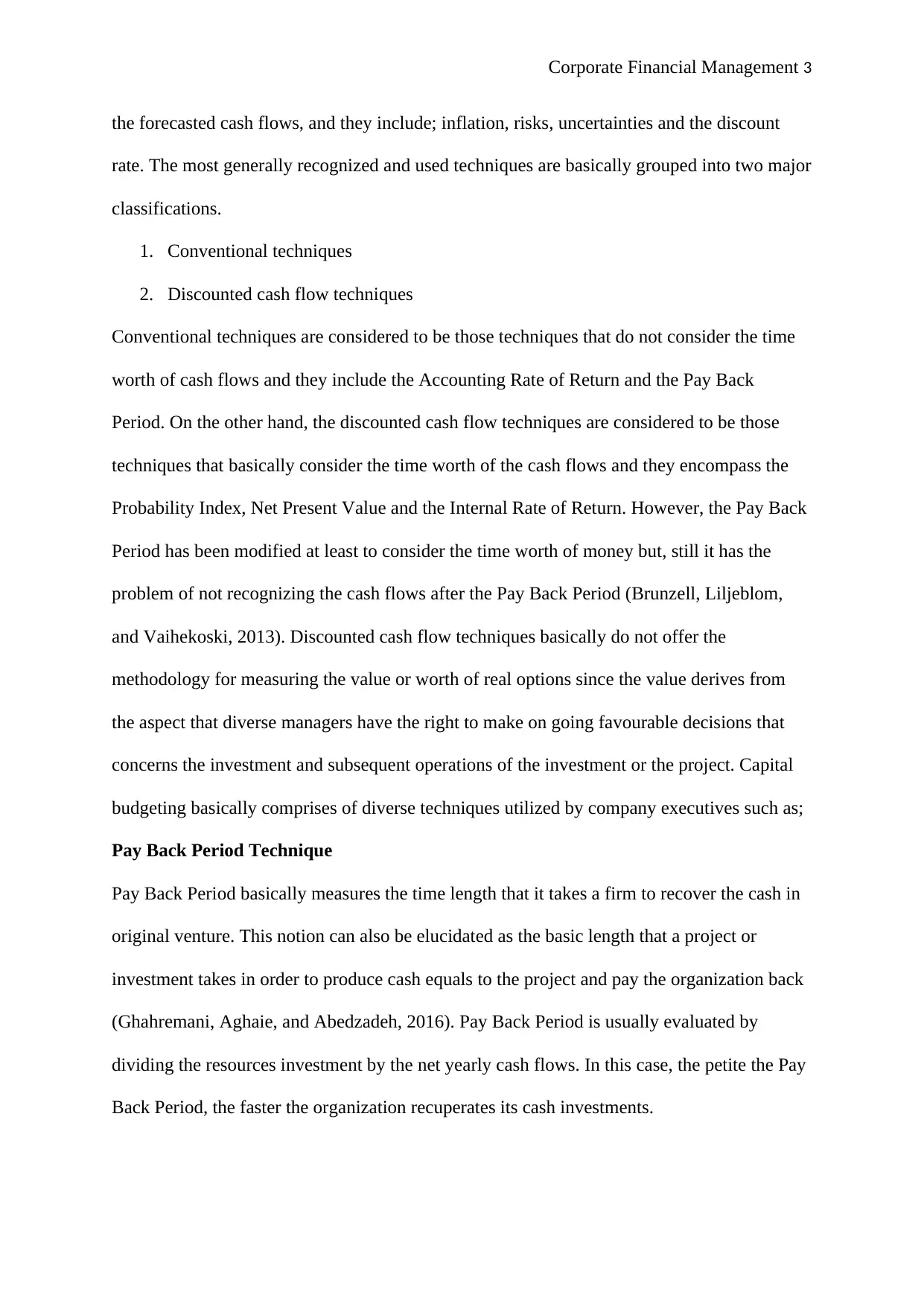
Corporate Financial Management 3
the forecasted cash flows, and they include; inflation, risks, uncertainties and the discount
rate. The most generally recognized and used techniques are basically grouped into two major
classifications.
1. Conventional techniques
2. Discounted cash flow techniques
Conventional techniques are considered to be those techniques that do not consider the time
worth of cash flows and they include the Accounting Rate of Return and the Pay Back
Period. On the other hand, the discounted cash flow techniques are considered to be those
techniques that basically consider the time worth of the cash flows and they encompass the
Probability Index, Net Present Value and the Internal Rate of Return. However, the Pay Back
Period has been modified at least to consider the time worth of money but, still it has the
problem of not recognizing the cash flows after the Pay Back Period (Brunzell, Liljeblom,
and Vaihekoski, 2013). Discounted cash flow techniques basically do not offer the
methodology for measuring the value or worth of real options since the value derives from
the aspect that diverse managers have the right to make on going favourable decisions that
concerns the investment and subsequent operations of the investment or the project. Capital
budgeting basically comprises of diverse techniques utilized by company executives such as;
Pay Back Period Technique
Pay Back Period basically measures the time length that it takes a firm to recover the cash in
original venture. This notion can also be elucidated as the basic length that a project or
investment takes in order to produce cash equals to the project and pay the organization back
(Ghahremani, Aghaie, and Abedzadeh, 2016). Pay Back Period is usually evaluated by
dividing the resources investment by the net yearly cash flows. In this case, the petite the Pay
Back Period, the faster the organization recuperates its cash investments.
the forecasted cash flows, and they include; inflation, risks, uncertainties and the discount
rate. The most generally recognized and used techniques are basically grouped into two major
classifications.
1. Conventional techniques
2. Discounted cash flow techniques
Conventional techniques are considered to be those techniques that do not consider the time
worth of cash flows and they include the Accounting Rate of Return and the Pay Back
Period. On the other hand, the discounted cash flow techniques are considered to be those
techniques that basically consider the time worth of the cash flows and they encompass the
Probability Index, Net Present Value and the Internal Rate of Return. However, the Pay Back
Period has been modified at least to consider the time worth of money but, still it has the
problem of not recognizing the cash flows after the Pay Back Period (Brunzell, Liljeblom,
and Vaihekoski, 2013). Discounted cash flow techniques basically do not offer the
methodology for measuring the value or worth of real options since the value derives from
the aspect that diverse managers have the right to make on going favourable decisions that
concerns the investment and subsequent operations of the investment or the project. Capital
budgeting basically comprises of diverse techniques utilized by company executives such as;
Pay Back Period Technique
Pay Back Period basically measures the time length that it takes a firm to recover the cash in
original venture. This notion can also be elucidated as the basic length that a project or
investment takes in order to produce cash equals to the project and pay the organization back
(Ghahremani, Aghaie, and Abedzadeh, 2016). Pay Back Period is usually evaluated by
dividing the resources investment by the net yearly cash flows. In this case, the petite the Pay
Back Period, the faster the organization recuperates its cash investments.
⊘ This is a preview!⊘
Do you want full access?
Subscribe today to unlock all pages.

Trusted by 1+ million students worldwide
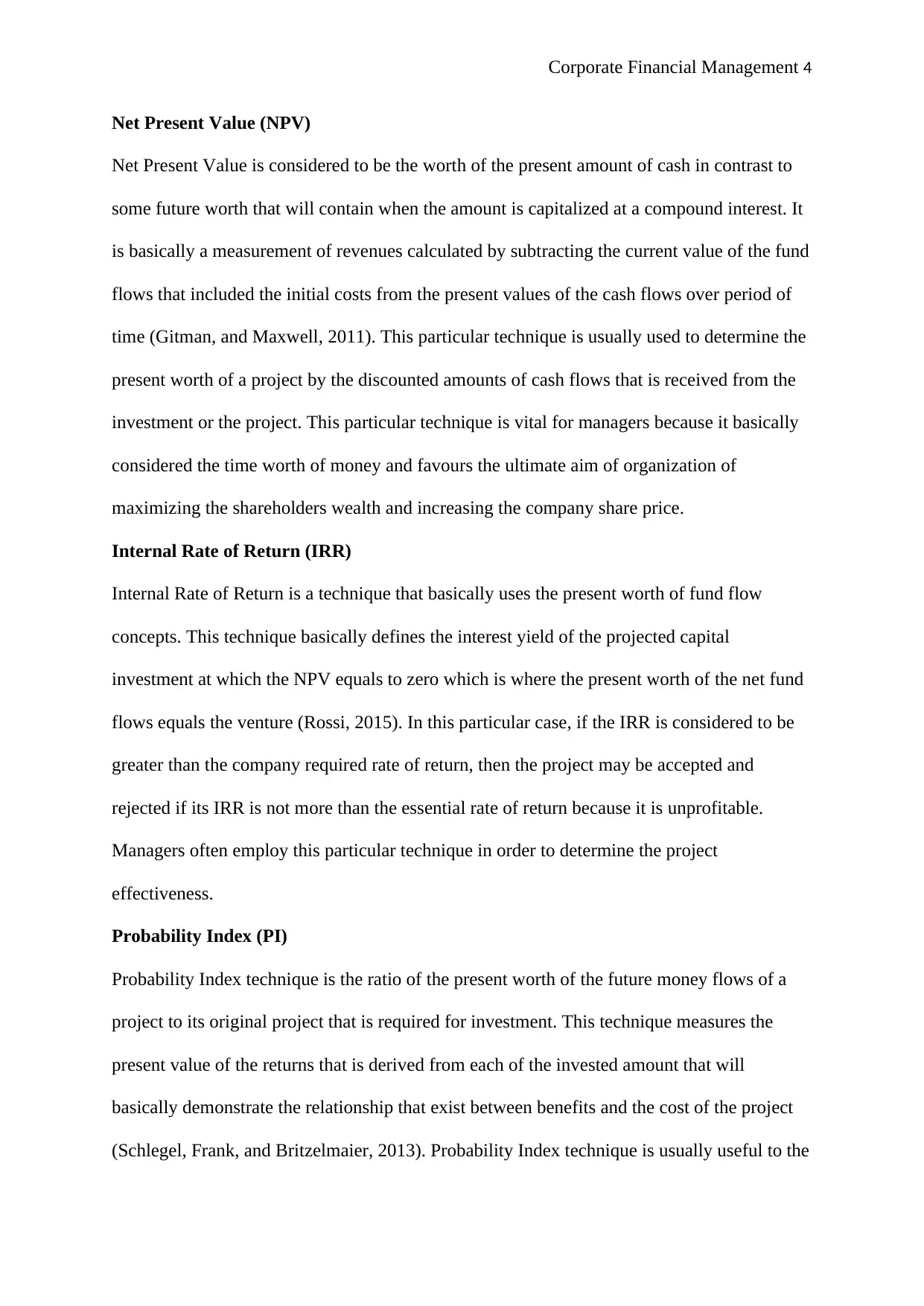
Corporate Financial Management 4
Net Present Value (NPV)
Net Present Value is considered to be the worth of the present amount of cash in contrast to
some future worth that will contain when the amount is capitalized at a compound interest. It
is basically a measurement of revenues calculated by subtracting the current value of the fund
flows that included the initial costs from the present values of the cash flows over period of
time (Gitman, and Maxwell, 2011). This particular technique is usually used to determine the
present worth of a project by the discounted amounts of cash flows that is received from the
investment or the project. This particular technique is vital for managers because it basically
considered the time worth of money and favours the ultimate aim of organization of
maximizing the shareholders wealth and increasing the company share price.
Internal Rate of Return (IRR)
Internal Rate of Return is a technique that basically uses the present worth of fund flow
concepts. This technique basically defines the interest yield of the projected capital
investment at which the NPV equals to zero which is where the present worth of the net fund
flows equals the venture (Rossi, 2015). In this particular case, if the IRR is considered to be
greater than the company required rate of return, then the project may be accepted and
rejected if its IRR is not more than the essential rate of return because it is unprofitable.
Managers often employ this particular technique in order to determine the project
effectiveness.
Probability Index (PI)
Probability Index technique is the ratio of the present worth of the future money flows of a
project to its original project that is required for investment. This technique measures the
present value of the returns that is derived from each of the invested amount that will
basically demonstrate the relationship that exist between benefits and the cost of the project
(Schlegel, Frank, and Britzelmaier, 2013). Probability Index technique is usually useful to the
Net Present Value (NPV)
Net Present Value is considered to be the worth of the present amount of cash in contrast to
some future worth that will contain when the amount is capitalized at a compound interest. It
is basically a measurement of revenues calculated by subtracting the current value of the fund
flows that included the initial costs from the present values of the cash flows over period of
time (Gitman, and Maxwell, 2011). This particular technique is usually used to determine the
present worth of a project by the discounted amounts of cash flows that is received from the
investment or the project. This particular technique is vital for managers because it basically
considered the time worth of money and favours the ultimate aim of organization of
maximizing the shareholders wealth and increasing the company share price.
Internal Rate of Return (IRR)
Internal Rate of Return is a technique that basically uses the present worth of fund flow
concepts. This technique basically defines the interest yield of the projected capital
investment at which the NPV equals to zero which is where the present worth of the net fund
flows equals the venture (Rossi, 2015). In this particular case, if the IRR is considered to be
greater than the company required rate of return, then the project may be accepted and
rejected if its IRR is not more than the essential rate of return because it is unprofitable.
Managers often employ this particular technique in order to determine the project
effectiveness.
Probability Index (PI)
Probability Index technique is the ratio of the present worth of the future money flows of a
project to its original project that is required for investment. This technique measures the
present value of the returns that is derived from each of the invested amount that will
basically demonstrate the relationship that exist between benefits and the cost of the project
(Schlegel, Frank, and Britzelmaier, 2013). Probability Index technique is usually useful to the
Paraphrase This Document
Need a fresh take? Get an instant paraphrase of this document with our AI Paraphraser
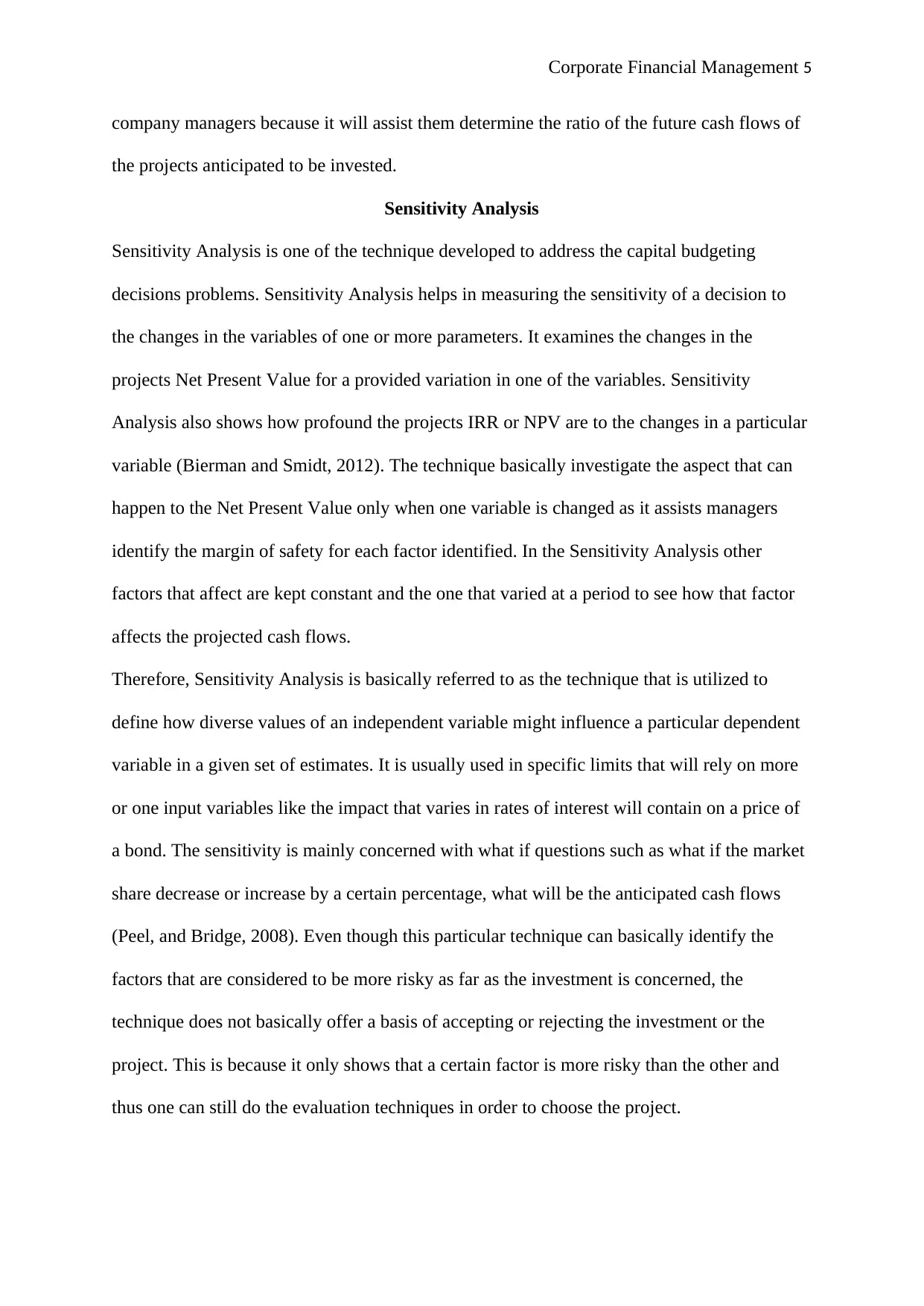
Corporate Financial Management 5
company managers because it will assist them determine the ratio of the future cash flows of
the projects anticipated to be invested.
Sensitivity Analysis
Sensitivity Analysis is one of the technique developed to address the capital budgeting
decisions problems. Sensitivity Analysis helps in measuring the sensitivity of a decision to
the changes in the variables of one or more parameters. It examines the changes in the
projects Net Present Value for a provided variation in one of the variables. Sensitivity
Analysis also shows how profound the projects IRR or NPV are to the changes in a particular
variable (Bierman and Smidt, 2012). The technique basically investigate the aspect that can
happen to the Net Present Value only when one variable is changed as it assists managers
identify the margin of safety for each factor identified. In the Sensitivity Analysis other
factors that affect are kept constant and the one that varied at a period to see how that factor
affects the projected cash flows.
Therefore, Sensitivity Analysis is basically referred to as the technique that is utilized to
define how diverse values of an independent variable might influence a particular dependent
variable in a given set of estimates. It is usually used in specific limits that will rely on more
or one input variables like the impact that varies in rates of interest will contain on a price of
a bond. The sensitivity is mainly concerned with what if questions such as what if the market
share decrease or increase by a certain percentage, what will be the anticipated cash flows
(Peel, and Bridge, 2008). Even though this particular technique can basically identify the
factors that are considered to be more risky as far as the investment is concerned, the
technique does not basically offer a basis of accepting or rejecting the investment or the
project. This is because it only shows that a certain factor is more risky than the other and
thus one can still do the evaluation techniques in order to choose the project.
company managers because it will assist them determine the ratio of the future cash flows of
the projects anticipated to be invested.
Sensitivity Analysis
Sensitivity Analysis is one of the technique developed to address the capital budgeting
decisions problems. Sensitivity Analysis helps in measuring the sensitivity of a decision to
the changes in the variables of one or more parameters. It examines the changes in the
projects Net Present Value for a provided variation in one of the variables. Sensitivity
Analysis also shows how profound the projects IRR or NPV are to the changes in a particular
variable (Bierman and Smidt, 2012). The technique basically investigate the aspect that can
happen to the Net Present Value only when one variable is changed as it assists managers
identify the margin of safety for each factor identified. In the Sensitivity Analysis other
factors that affect are kept constant and the one that varied at a period to see how that factor
affects the projected cash flows.
Therefore, Sensitivity Analysis is basically referred to as the technique that is utilized to
define how diverse values of an independent variable might influence a particular dependent
variable in a given set of estimates. It is usually used in specific limits that will rely on more
or one input variables like the impact that varies in rates of interest will contain on a price of
a bond. The sensitivity is mainly concerned with what if questions such as what if the market
share decrease or increase by a certain percentage, what will be the anticipated cash flows
(Peel, and Bridge, 2008). Even though this particular technique can basically identify the
factors that are considered to be more risky as far as the investment is concerned, the
technique does not basically offer a basis of accepting or rejecting the investment or the
project. This is because it only shows that a certain factor is more risky than the other and
thus one can still do the evaluation techniques in order to choose the project.
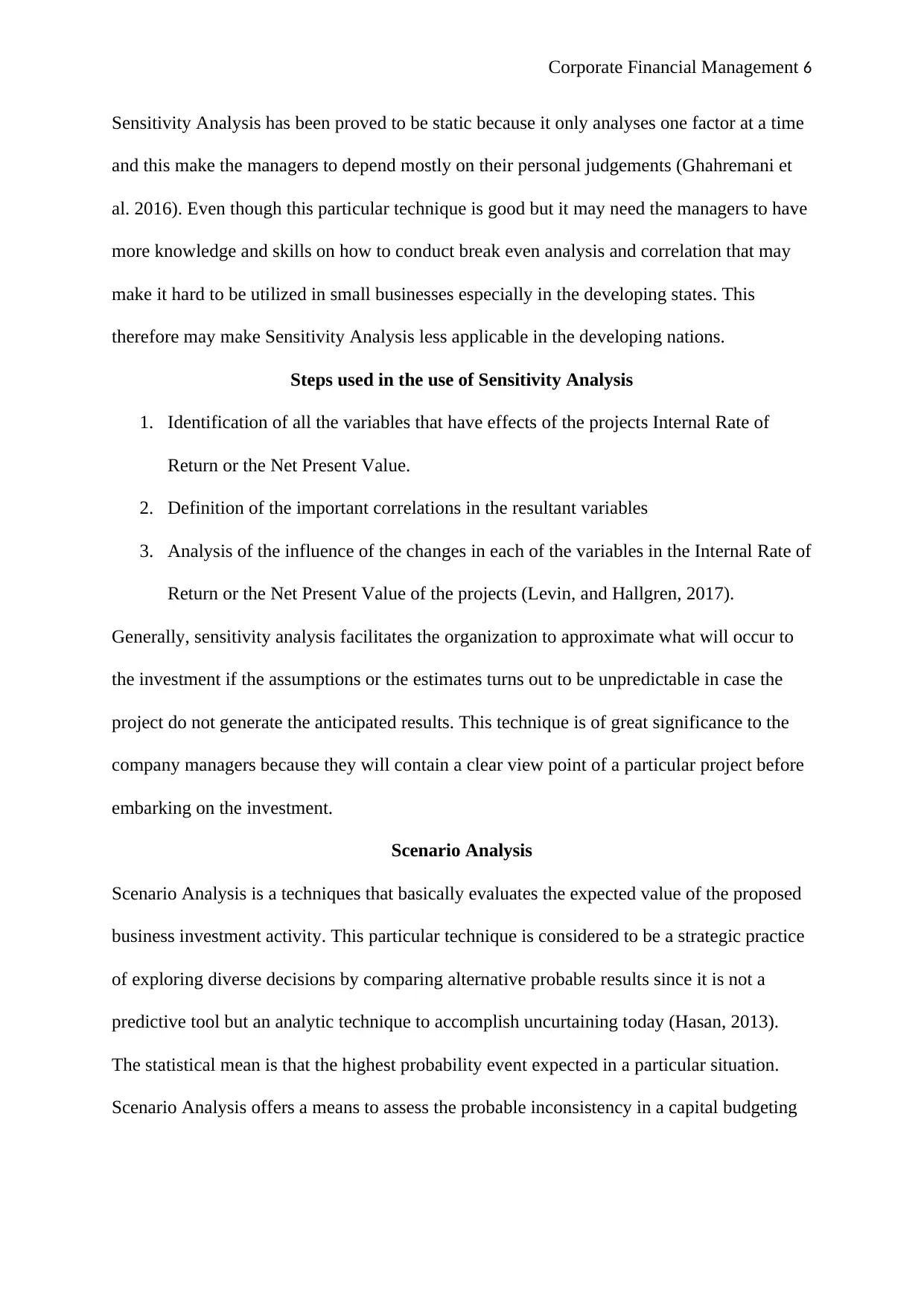
Corporate Financial Management 6
Sensitivity Analysis has been proved to be static because it only analyses one factor at a time
and this make the managers to depend mostly on their personal judgements (Ghahremani et
al. 2016). Even though this particular technique is good but it may need the managers to have
more knowledge and skills on how to conduct break even analysis and correlation that may
make it hard to be utilized in small businesses especially in the developing states. This
therefore may make Sensitivity Analysis less applicable in the developing nations.
Steps used in the use of Sensitivity Analysis
1. Identification of all the variables that have effects of the projects Internal Rate of
Return or the Net Present Value.
2. Definition of the important correlations in the resultant variables
3. Analysis of the influence of the changes in each of the variables in the Internal Rate of
Return or the Net Present Value of the projects (Levin, and Hallgren, 2017).
Generally, sensitivity analysis facilitates the organization to approximate what will occur to
the investment if the assumptions or the estimates turns out to be unpredictable in case the
project do not generate the anticipated results. This technique is of great significance to the
company managers because they will contain a clear view point of a particular project before
embarking on the investment.
Scenario Analysis
Scenario Analysis is a techniques that basically evaluates the expected value of the proposed
business investment activity. This particular technique is considered to be a strategic practice
of exploring diverse decisions by comparing alternative probable results since it is not a
predictive tool but an analytic technique to accomplish uncurtaining today (Hasan, 2013).
The statistical mean is that the highest probability event expected in a particular situation.
Scenario Analysis offers a means to assess the probable inconsistency in a capital budgeting
Sensitivity Analysis has been proved to be static because it only analyses one factor at a time
and this make the managers to depend mostly on their personal judgements (Ghahremani et
al. 2016). Even though this particular technique is good but it may need the managers to have
more knowledge and skills on how to conduct break even analysis and correlation that may
make it hard to be utilized in small businesses especially in the developing states. This
therefore may make Sensitivity Analysis less applicable in the developing nations.
Steps used in the use of Sensitivity Analysis
1. Identification of all the variables that have effects of the projects Internal Rate of
Return or the Net Present Value.
2. Definition of the important correlations in the resultant variables
3. Analysis of the influence of the changes in each of the variables in the Internal Rate of
Return or the Net Present Value of the projects (Levin, and Hallgren, 2017).
Generally, sensitivity analysis facilitates the organization to approximate what will occur to
the investment if the assumptions or the estimates turns out to be unpredictable in case the
project do not generate the anticipated results. This technique is of great significance to the
company managers because they will contain a clear view point of a particular project before
embarking on the investment.
Scenario Analysis
Scenario Analysis is a techniques that basically evaluates the expected value of the proposed
business investment activity. This particular technique is considered to be a strategic practice
of exploring diverse decisions by comparing alternative probable results since it is not a
predictive tool but an analytic technique to accomplish uncurtaining today (Hasan, 2013).
The statistical mean is that the highest probability event expected in a particular situation.
Scenario Analysis offers a means to assess the probable inconsistency in a capital budgeting
⊘ This is a preview!⊘
Do you want full access?
Subscribe today to unlock all pages.

Trusted by 1+ million students worldwide
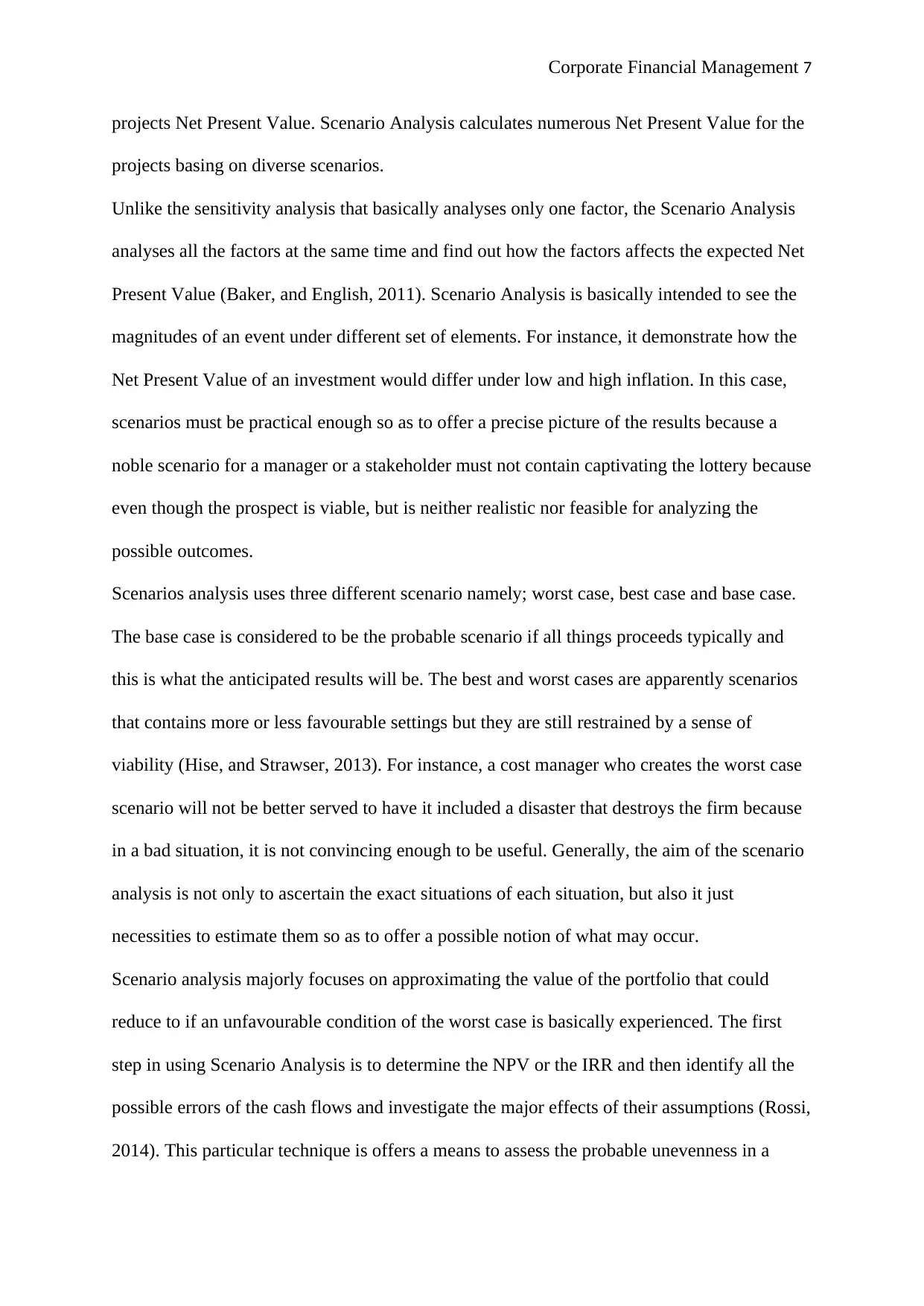
Corporate Financial Management 7
projects Net Present Value. Scenario Analysis calculates numerous Net Present Value for the
projects basing on diverse scenarios.
Unlike the sensitivity analysis that basically analyses only one factor, the Scenario Analysis
analyses all the factors at the same time and find out how the factors affects the expected Net
Present Value (Baker, and English, 2011). Scenario Analysis is basically intended to see the
magnitudes of an event under different set of elements. For instance, it demonstrate how the
Net Present Value of an investment would differ under low and high inflation. In this case,
scenarios must be practical enough so as to offer a precise picture of the results because a
noble scenario for a manager or a stakeholder must not contain captivating the lottery because
even though the prospect is viable, but is neither realistic nor feasible for analyzing the
possible outcomes.
Scenarios analysis uses three different scenario namely; worst case, best case and base case.
The base case is considered to be the probable scenario if all things proceeds typically and
this is what the anticipated results will be. The best and worst cases are apparently scenarios
that contains more or less favourable settings but they are still restrained by a sense of
viability (Hise, and Strawser, 2013). For instance, a cost manager who creates the worst case
scenario will not be better served to have it included a disaster that destroys the firm because
in a bad situation, it is not convincing enough to be useful. Generally, the aim of the scenario
analysis is not only to ascertain the exact situations of each situation, but also it just
necessities to estimate them so as to offer a possible notion of what may occur.
Scenario analysis majorly focuses on approximating the value of the portfolio that could
reduce to if an unfavourable condition of the worst case is basically experienced. The first
step in using Scenario Analysis is to determine the NPV or the IRR and then identify all the
possible errors of the cash flows and investigate the major effects of their assumptions (Rossi,
2014). This particular technique is offers a means to assess the probable unevenness in a
projects Net Present Value. Scenario Analysis calculates numerous Net Present Value for the
projects basing on diverse scenarios.
Unlike the sensitivity analysis that basically analyses only one factor, the Scenario Analysis
analyses all the factors at the same time and find out how the factors affects the expected Net
Present Value (Baker, and English, 2011). Scenario Analysis is basically intended to see the
magnitudes of an event under different set of elements. For instance, it demonstrate how the
Net Present Value of an investment would differ under low and high inflation. In this case,
scenarios must be practical enough so as to offer a precise picture of the results because a
noble scenario for a manager or a stakeholder must not contain captivating the lottery because
even though the prospect is viable, but is neither realistic nor feasible for analyzing the
possible outcomes.
Scenarios analysis uses three different scenario namely; worst case, best case and base case.
The base case is considered to be the probable scenario if all things proceeds typically and
this is what the anticipated results will be. The best and worst cases are apparently scenarios
that contains more or less favourable settings but they are still restrained by a sense of
viability (Hise, and Strawser, 2013). For instance, a cost manager who creates the worst case
scenario will not be better served to have it included a disaster that destroys the firm because
in a bad situation, it is not convincing enough to be useful. Generally, the aim of the scenario
analysis is not only to ascertain the exact situations of each situation, but also it just
necessities to estimate them so as to offer a possible notion of what may occur.
Scenario analysis majorly focuses on approximating the value of the portfolio that could
reduce to if an unfavourable condition of the worst case is basically experienced. The first
step in using Scenario Analysis is to determine the NPV or the IRR and then identify all the
possible errors of the cash flows and investigate the major effects of their assumptions (Rossi,
2014). This particular technique is offers a means to assess the probable unevenness in a
Paraphrase This Document
Need a fresh take? Get an instant paraphrase of this document with our AI Paraphraser
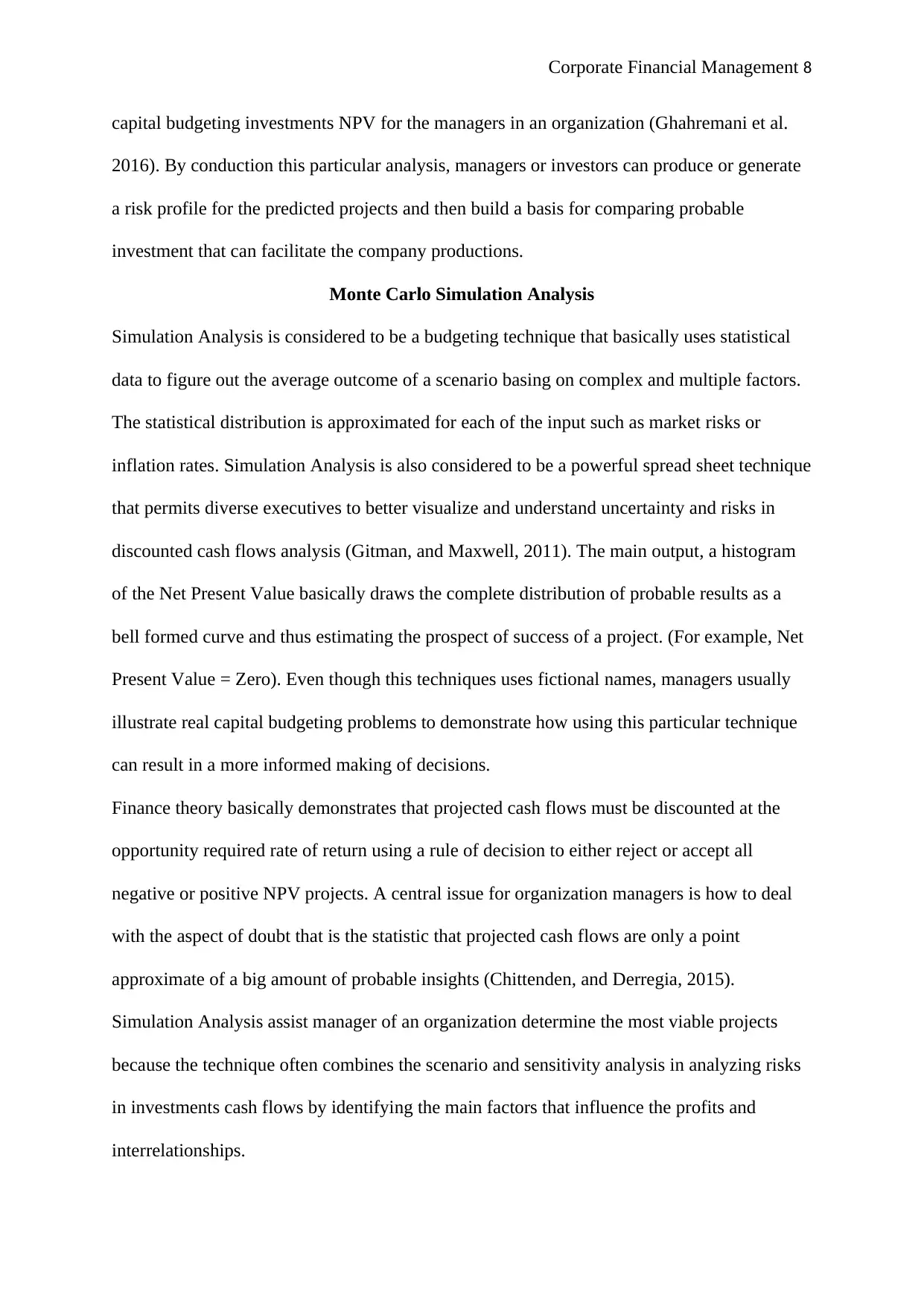
Corporate Financial Management 8
capital budgeting investments NPV for the managers in an organization (Ghahremani et al.
2016). By conduction this particular analysis, managers or investors can produce or generate
a risk profile for the predicted projects and then build a basis for comparing probable
investment that can facilitate the company productions.
Monte Carlo Simulation Analysis
Simulation Analysis is considered to be a budgeting technique that basically uses statistical
data to figure out the average outcome of a scenario basing on complex and multiple factors.
The statistical distribution is approximated for each of the input such as market risks or
inflation rates. Simulation Analysis is also considered to be a powerful spread sheet technique
that permits diverse executives to better visualize and understand uncertainty and risks in
discounted cash flows analysis (Gitman, and Maxwell, 2011). The main output, a histogram
of the Net Present Value basically draws the complete distribution of probable results as a
bell formed curve and thus estimating the prospect of success of a project. (For example, Net
Present Value = Zero). Even though this techniques uses fictional names, managers usually
illustrate real capital budgeting problems to demonstrate how using this particular technique
can result in a more informed making of decisions.
Finance theory basically demonstrates that projected cash flows must be discounted at the
opportunity required rate of return using a rule of decision to either reject or accept all
negative or positive NPV projects. A central issue for organization managers is how to deal
with the aspect of doubt that is the statistic that projected cash flows are only a point
approximate of a big amount of probable insights (Chittenden, and Derregia, 2015).
Simulation Analysis assist manager of an organization determine the most viable projects
because the technique often combines the scenario and sensitivity analysis in analyzing risks
in investments cash flows by identifying the main factors that influence the profits and
interrelationships.
capital budgeting investments NPV for the managers in an organization (Ghahremani et al.
2016). By conduction this particular analysis, managers or investors can produce or generate
a risk profile for the predicted projects and then build a basis for comparing probable
investment that can facilitate the company productions.
Monte Carlo Simulation Analysis
Simulation Analysis is considered to be a budgeting technique that basically uses statistical
data to figure out the average outcome of a scenario basing on complex and multiple factors.
The statistical distribution is approximated for each of the input such as market risks or
inflation rates. Simulation Analysis is also considered to be a powerful spread sheet technique
that permits diverse executives to better visualize and understand uncertainty and risks in
discounted cash flows analysis (Gitman, and Maxwell, 2011). The main output, a histogram
of the Net Present Value basically draws the complete distribution of probable results as a
bell formed curve and thus estimating the prospect of success of a project. (For example, Net
Present Value = Zero). Even though this techniques uses fictional names, managers usually
illustrate real capital budgeting problems to demonstrate how using this particular technique
can result in a more informed making of decisions.
Finance theory basically demonstrates that projected cash flows must be discounted at the
opportunity required rate of return using a rule of decision to either reject or accept all
negative or positive NPV projects. A central issue for organization managers is how to deal
with the aspect of doubt that is the statistic that projected cash flows are only a point
approximate of a big amount of probable insights (Chittenden, and Derregia, 2015).
Simulation Analysis assist manager of an organization determine the most viable projects
because the technique often combines the scenario and sensitivity analysis in analyzing risks
in investments cash flows by identifying the main factors that influence the profits and
interrelationships.
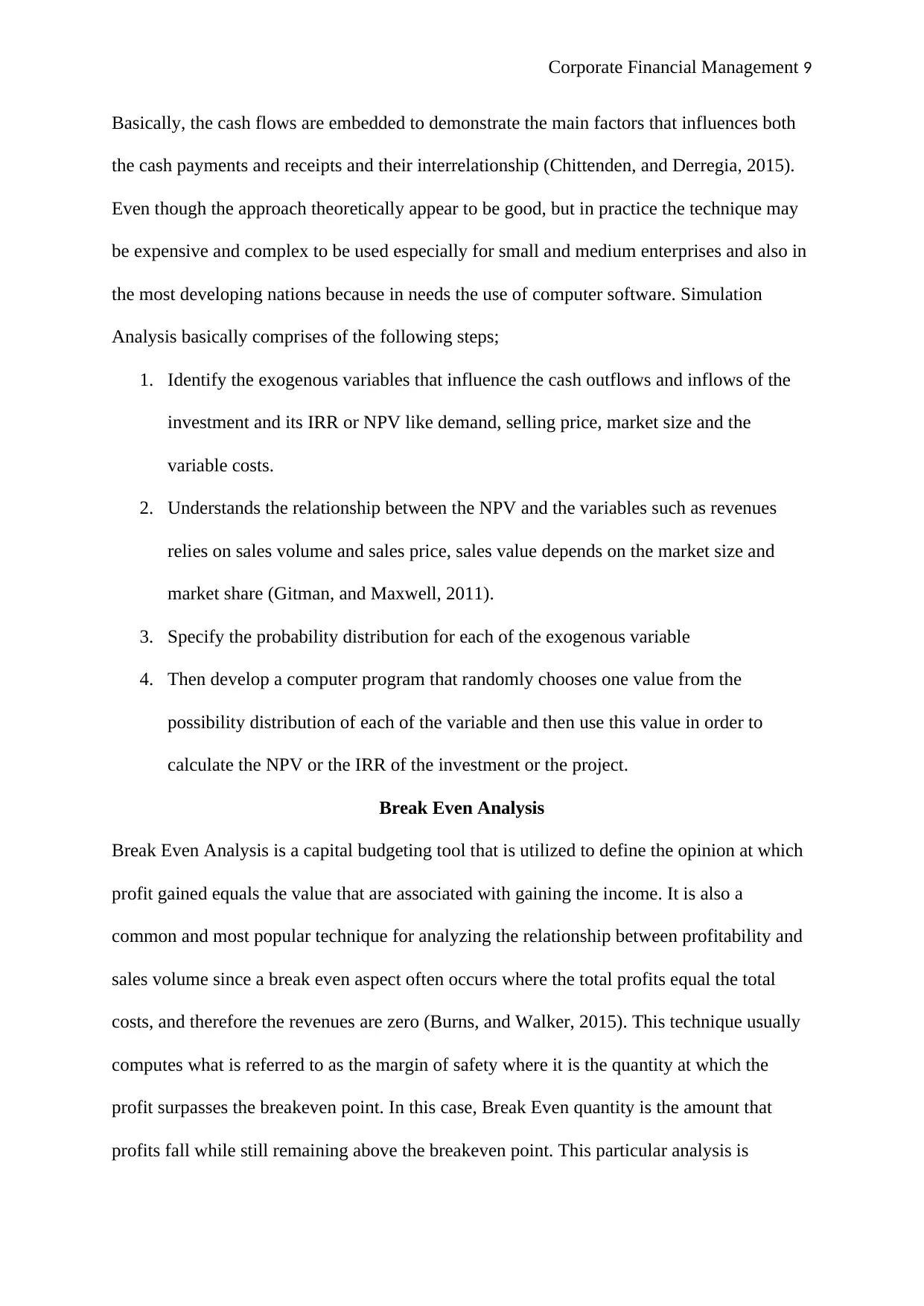
Corporate Financial Management 9
Basically, the cash flows are embedded to demonstrate the main factors that influences both
the cash payments and receipts and their interrelationship (Chittenden, and Derregia, 2015).
Even though the approach theoretically appear to be good, but in practice the technique may
be expensive and complex to be used especially for small and medium enterprises and also in
the most developing nations because in needs the use of computer software. Simulation
Analysis basically comprises of the following steps;
1. Identify the exogenous variables that influence the cash outflows and inflows of the
investment and its IRR or NPV like demand, selling price, market size and the
variable costs.
2. Understands the relationship between the NPV and the variables such as revenues
relies on sales volume and sales price, sales value depends on the market size and
market share (Gitman, and Maxwell, 2011).
3. Specify the probability distribution for each of the exogenous variable
4. Then develop a computer program that randomly chooses one value from the
possibility distribution of each of the variable and then use this value in order to
calculate the NPV or the IRR of the investment or the project.
Break Even Analysis
Break Even Analysis is a capital budgeting tool that is utilized to define the opinion at which
profit gained equals the value that are associated with gaining the income. It is also a
common and most popular technique for analyzing the relationship between profitability and
sales volume since a break even aspect often occurs where the total profits equal the total
costs, and therefore the revenues are zero (Burns, and Walker, 2015). This technique usually
computes what is referred to as the margin of safety where it is the quantity at which the
profit surpasses the breakeven point. In this case, Break Even quantity is the amount that
profits fall while still remaining above the breakeven point. This particular analysis is
Basically, the cash flows are embedded to demonstrate the main factors that influences both
the cash payments and receipts and their interrelationship (Chittenden, and Derregia, 2015).
Even though the approach theoretically appear to be good, but in practice the technique may
be expensive and complex to be used especially for small and medium enterprises and also in
the most developing nations because in needs the use of computer software. Simulation
Analysis basically comprises of the following steps;
1. Identify the exogenous variables that influence the cash outflows and inflows of the
investment and its IRR or NPV like demand, selling price, market size and the
variable costs.
2. Understands the relationship between the NPV and the variables such as revenues
relies on sales volume and sales price, sales value depends on the market size and
market share (Gitman, and Maxwell, 2011).
3. Specify the probability distribution for each of the exogenous variable
4. Then develop a computer program that randomly chooses one value from the
possibility distribution of each of the variable and then use this value in order to
calculate the NPV or the IRR of the investment or the project.
Break Even Analysis
Break Even Analysis is a capital budgeting tool that is utilized to define the opinion at which
profit gained equals the value that are associated with gaining the income. It is also a
common and most popular technique for analyzing the relationship between profitability and
sales volume since a break even aspect often occurs where the total profits equal the total
costs, and therefore the revenues are zero (Burns, and Walker, 2015). This technique usually
computes what is referred to as the margin of safety where it is the quantity at which the
profit surpasses the breakeven point. In this case, Break Even quantity is the amount that
profits fall while still remaining above the breakeven point. This particular analysis is
⊘ This is a preview!⊘
Do you want full access?
Subscribe today to unlock all pages.

Trusted by 1+ million students worldwide
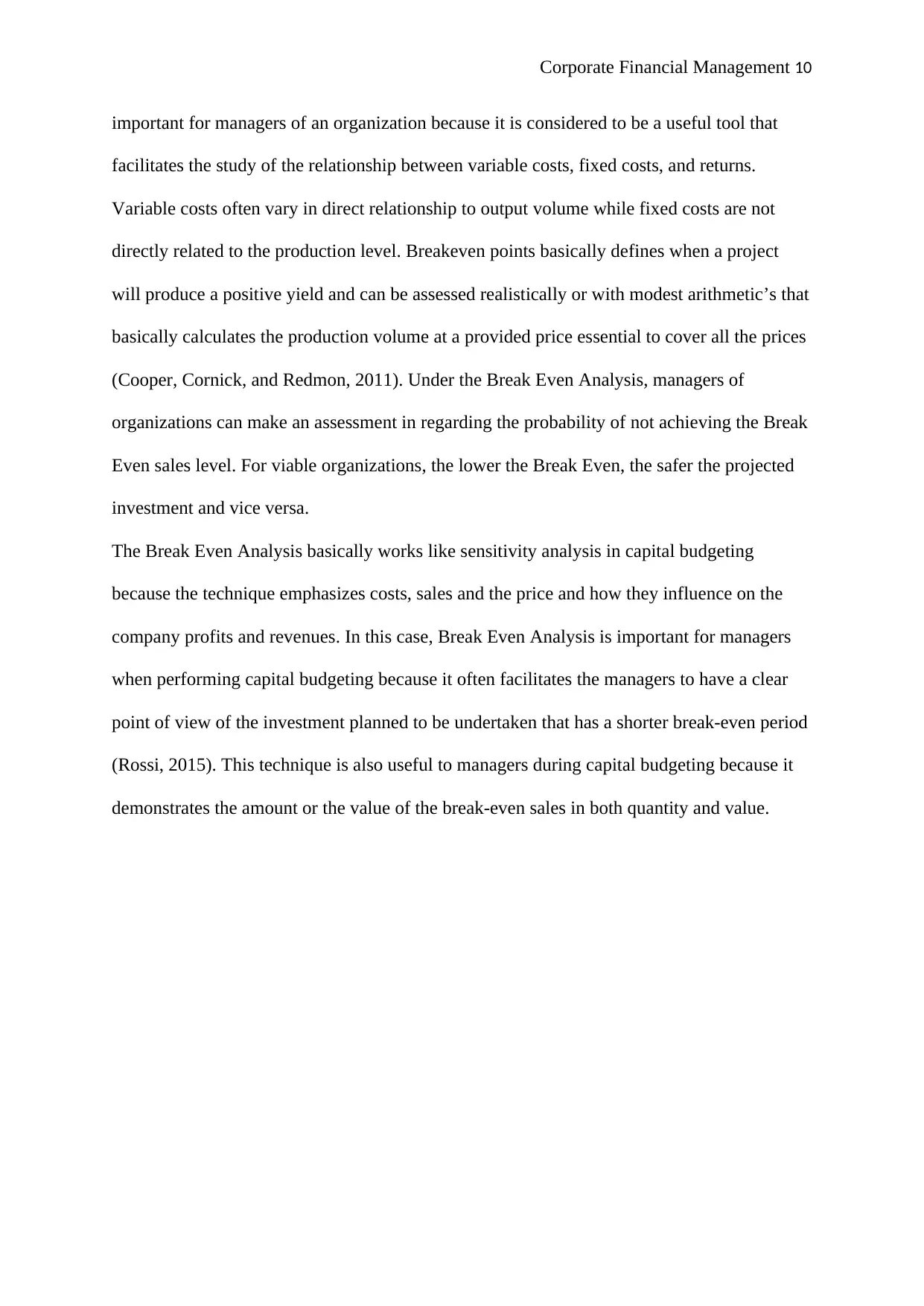
Corporate Financial Management 10
important for managers of an organization because it is considered to be a useful tool that
facilitates the study of the relationship between variable costs, fixed costs, and returns.
Variable costs often vary in direct relationship to output volume while fixed costs are not
directly related to the production level. Breakeven points basically defines when a project
will produce a positive yield and can be assessed realistically or with modest arithmetic’s that
basically calculates the production volume at a provided price essential to cover all the prices
(Cooper, Cornick, and Redmon, 2011). Under the Break Even Analysis, managers of
organizations can make an assessment in regarding the probability of not achieving the Break
Even sales level. For viable organizations, the lower the Break Even, the safer the projected
investment and vice versa.
The Break Even Analysis basically works like sensitivity analysis in capital budgeting
because the technique emphasizes costs, sales and the price and how they influence on the
company profits and revenues. In this case, Break Even Analysis is important for managers
when performing capital budgeting because it often facilitates the managers to have a clear
point of view of the investment planned to be undertaken that has a shorter break-even period
(Rossi, 2015). This technique is also useful to managers during capital budgeting because it
demonstrates the amount or the value of the break-even sales in both quantity and value.
important for managers of an organization because it is considered to be a useful tool that
facilitates the study of the relationship between variable costs, fixed costs, and returns.
Variable costs often vary in direct relationship to output volume while fixed costs are not
directly related to the production level. Breakeven points basically defines when a project
will produce a positive yield and can be assessed realistically or with modest arithmetic’s that
basically calculates the production volume at a provided price essential to cover all the prices
(Cooper, Cornick, and Redmon, 2011). Under the Break Even Analysis, managers of
organizations can make an assessment in regarding the probability of not achieving the Break
Even sales level. For viable organizations, the lower the Break Even, the safer the projected
investment and vice versa.
The Break Even Analysis basically works like sensitivity analysis in capital budgeting
because the technique emphasizes costs, sales and the price and how they influence on the
company profits and revenues. In this case, Break Even Analysis is important for managers
when performing capital budgeting because it often facilitates the managers to have a clear
point of view of the investment planned to be undertaken that has a shorter break-even period
(Rossi, 2015). This technique is also useful to managers during capital budgeting because it
demonstrates the amount or the value of the break-even sales in both quantity and value.
Paraphrase This Document
Need a fresh take? Get an instant paraphrase of this document with our AI Paraphraser

Corporate Financial Management 11
Bibliography
Andor, G., Mohanty, S.K. and Toth, T., 2015. Capital budgeting practices: A survey of
Central and Eastern European firms. Emerging Markets Review, 23, pp.148-172.
Baker, H.K. and English, P., 2011. Capital budgeting valuation: Financial analysis for
today's investment projects (Vol. 13). John Wiley & Sons.
Bierman Jr, H. and Smidt, S., 2012. The capital budgeting decision: economic analysis of
investment projects. Routledge.
Burns, R. and Walker, J., 2015. Capital budgeting surveys: the future is now.
Brunzell, T., Liljeblom, E. and Vaihekoski, M., 2013. Determinants of capital budgeting
methods and hurdle rates in Nordic firms. Accounting & Finance, 53(1), pp.85-110.
Cooper, W.D., Cornick, M.F. and Redmon, A., 2011. Capital budgeting: A 1990 study of
Fortune 500 company practices. Journal of Applied Business Research, 8(3), pp.20-23.
Chittenden, F. and Derregia, M., 2015. Uncertainty, irreversibility and the use of ‘rules of
thumb’in capital budgeting. The British Accounting Review, 47(3), pp.225-236.
Ghahremani, M., Aghaie, A. and Abedzadeh, M., 2012. Capital budgeting technique selection
through four decades: with a great focus on real option. International Journal of Business
and Management, 7(17), p.98.
Gitman, L.J. and Maxwell, C.E., 2011. A Longitudinal comparison of capital budgeting
techniques used by major US firms: 1986 versus 1976. Journal of Applied Business Research
(JABR), 3(3), pp.41-50.
Hasan, M., 2013. Capital budgeting techniques used by small manufacturing
companies. Journal of Service Science and Management, 6(01), p.38.
Hise, R.T. and Strawser, R.H., 2013. Application of Capital Budgeting Techniques to
Marketing Operations. Readings in Managerial Economics: Pergamon International Library
of Science, Technology, Engineering and Social Studies, p.419.
Bibliography
Andor, G., Mohanty, S.K. and Toth, T., 2015. Capital budgeting practices: A survey of
Central and Eastern European firms. Emerging Markets Review, 23, pp.148-172.
Baker, H.K. and English, P., 2011. Capital budgeting valuation: Financial analysis for
today's investment projects (Vol. 13). John Wiley & Sons.
Bierman Jr, H. and Smidt, S., 2012. The capital budgeting decision: economic analysis of
investment projects. Routledge.
Burns, R. and Walker, J., 2015. Capital budgeting surveys: the future is now.
Brunzell, T., Liljeblom, E. and Vaihekoski, M., 2013. Determinants of capital budgeting
methods and hurdle rates in Nordic firms. Accounting & Finance, 53(1), pp.85-110.
Cooper, W.D., Cornick, M.F. and Redmon, A., 2011. Capital budgeting: A 1990 study of
Fortune 500 company practices. Journal of Applied Business Research, 8(3), pp.20-23.
Chittenden, F. and Derregia, M., 2015. Uncertainty, irreversibility and the use of ‘rules of
thumb’in capital budgeting. The British Accounting Review, 47(3), pp.225-236.
Ghahremani, M., Aghaie, A. and Abedzadeh, M., 2012. Capital budgeting technique selection
through four decades: with a great focus on real option. International Journal of Business
and Management, 7(17), p.98.
Gitman, L.J. and Maxwell, C.E., 2011. A Longitudinal comparison of capital budgeting
techniques used by major US firms: 1986 versus 1976. Journal of Applied Business Research
(JABR), 3(3), pp.41-50.
Hasan, M., 2013. Capital budgeting techniques used by small manufacturing
companies. Journal of Service Science and Management, 6(01), p.38.
Hise, R.T. and Strawser, R.H., 2013. Application of Capital Budgeting Techniques to
Marketing Operations. Readings in Managerial Economics: Pergamon International Library
of Science, Technology, Engineering and Social Studies, p.419.

Corporate Financial Management 12
Levin, V. and Hallgren, A., 2017. The choice of capital budgeting techniques: a human
capital approach.
Peel, M.J. and Bridge, J., 2008. How planning and capital budgeting improve SME
performance. Long Range Planning, 31(6), pp.848-856.
Rossi, M., 2015. The use of capital budgeting techniques: an outlook from
Italy. International Journal of Management Practice, 8(1), pp.43-56.
Rossi, M., 2014. Capital budgeting in Europe: confronting theory with practice. International
Journal of Managerial and Financial Accounting, 6(4), pp.341-356.
Schlegel, D., Frank, F. and Britzelmaier, B., 2016. Investment decisions and capital
budgeting practices in German manufacturing companies. International Journal of Business
and Globalisation, 16(1), pp.66-78.
Levin, V. and Hallgren, A., 2017. The choice of capital budgeting techniques: a human
capital approach.
Peel, M.J. and Bridge, J., 2008. How planning and capital budgeting improve SME
performance. Long Range Planning, 31(6), pp.848-856.
Rossi, M., 2015. The use of capital budgeting techniques: an outlook from
Italy. International Journal of Management Practice, 8(1), pp.43-56.
Rossi, M., 2014. Capital budgeting in Europe: confronting theory with practice. International
Journal of Managerial and Financial Accounting, 6(4), pp.341-356.
Schlegel, D., Frank, F. and Britzelmaier, B., 2016. Investment decisions and capital
budgeting practices in German manufacturing companies. International Journal of Business
and Globalisation, 16(1), pp.66-78.
⊘ This is a preview!⊘
Do you want full access?
Subscribe today to unlock all pages.

Trusted by 1+ million students worldwide
1 out of 12
Related Documents
Your All-in-One AI-Powered Toolkit for Academic Success.
+13062052269
info@desklib.com
Available 24*7 on WhatsApp / Email
![[object Object]](/_next/static/media/star-bottom.7253800d.svg)
Unlock your academic potential
Copyright © 2020–2025 A2Z Services. All Rights Reserved. Developed and managed by ZUCOL.




